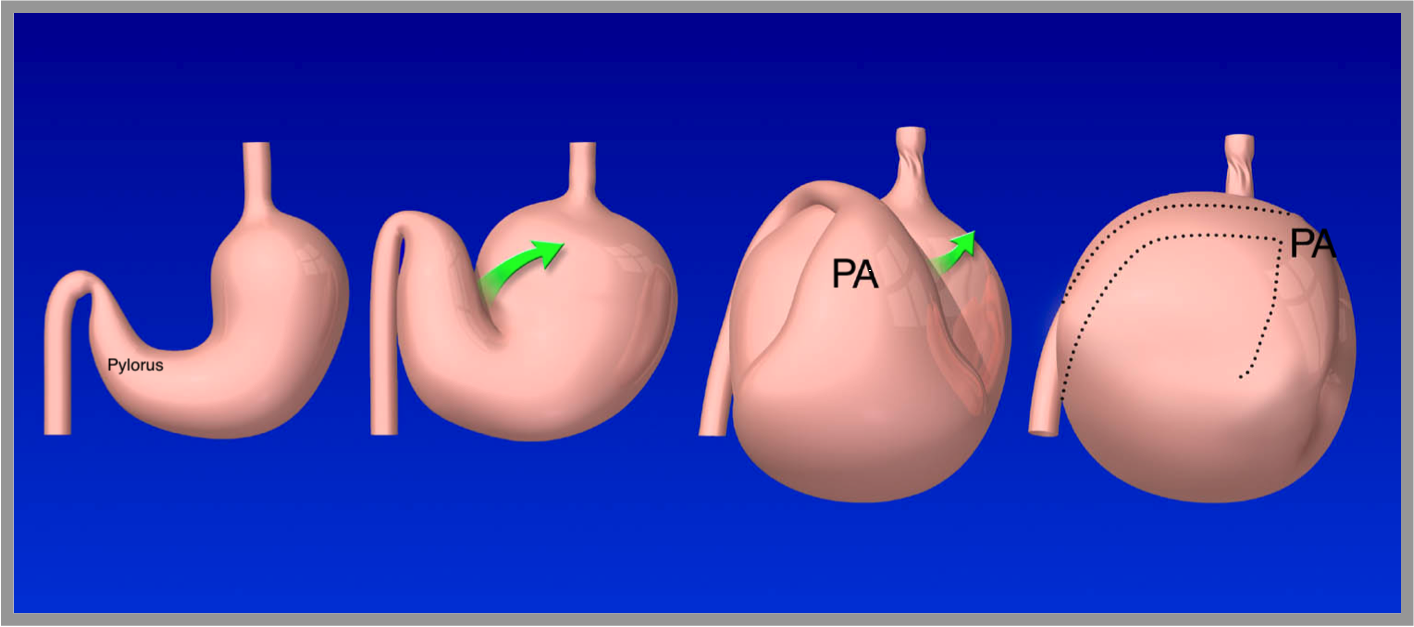
Prophylactic Gastropexy
What is a prophylactic gastropexy?
A prophylactic gastropexy is a preventative surgical procedure performed on dogs to reduce the risk of gastric dilatation volvulus (GDV), also known as bloat or a twisted stomach.
What is Gastric Dilatation Volvulus (GDV)?
A GDV is a life-threatening situation where the stomach fills with air and turns over on itself, interrupting its blood supply and quickly leading to shock and death.
Figure 1: Anatomic changes during the development of GDV, from left to right: The stomach in a normal anatomic position. The pyloric antrum (PA) moves from the right of the dog to the left. On the far right, the PA is located on the left side of the body.
During a gastropexy, the stomach is permanently attached to the body wall to prevent it from twisting.
Who should consider a gastropexy?
There are certain breed and body conformations that put dogs at a higher risk for GDV. Personality and genetics also play a roll. A prophylactic gastropexy is most commonly recommended for:
Large, deep chested breeds (Standard poodles, Great Danes, Labrador Retrievers, German Shepherds, Weimaraners and others)
Dogs with a familial history of GDV
Dogs who have previously experienced bloat or GDV
Other factors that predispose to GDV that have been identified include:
Increasing age
Feeding a large meal, once per day
Eating quickly or exercising soon after eating
Nervous, fearful temperament
Stressful situations such as boarding or storms
A prophylactic gastropexy can often be performed in conjunction with a routine surgery such as a spay or neuter in high-risk dogs or it can be performed as a stand-alone procedure.
What is recovery like?
After surgery your pet will need to have activity limited for about 10-14 days. No running, jumping or playing should be allowed. The incision should be monitored for any redness, swelling or discharge and an E-collar should be used to prevent your pet from licking or chewing the incision. Pain medications will be prescribed to be given for several days after surgery and in some cases antibiotics will also be sent home.
Immediately post-surgery, your pet may be drowsy, uncoordinated or nauseous. Unless otherwise instructed, we normally recommend the following for food and water:
Water Reintroduction: Offer a small amount of water 30 minutes to 1 hour after arriving. If there are no signs of nausea and water is kept down, more can be offered in small amounts. You may resume normal water access the following day,
Food Reintroduction: Offer 1/2 their normal feed 2 hours after arriving home. If there are no signs of nausea and food is kept down, please feed 2/3 their normal feed for the next 2-3 days. You may resume normal feedings the following day if no signs of nausea (vomiting, excessive drooling - contact us if they appear nauseous).
Detailed postoperative instructions will be provided to you after the surgery that outline medications, and incision care. Bandages on the IV catheter site can be removed once you get home. It is normal for some bruising and swelling to occur. If there is no pain or discharge associated with the swelling, continue to monitor at home. Please notify us or your veterinarian if you observe:
Increased redness/bruising over time
Odorous or pus-like discharge
Opening of the incision site
Increased swelling
Vomiting
Signs of acute pain.
Prognosis
A gastropexy is very effective, however in rare cases, the stomach may fail to permanently adhere to the body wall and a GDV may occur. Signs of GDV include non-productive retching, abdominal distension and collapse. Your dog should be evaluated immediately by a veterinarian if any of these signs are observed, it is an emergency.

